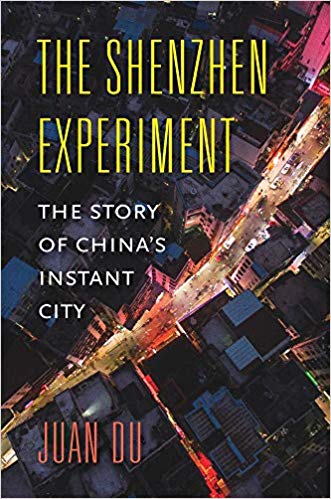
Review of The Shenzhen Experiment: the Story of China’s Instant City by Juan Du. Harvard University Press, 2020.
What is a great city without an audacious myth, a myth that shapes the ethos of its people, beckons newcomers to it, and keeps its inhabitants in its thrall? While outside of China, Shenzhen, among its many superlatives, may be the world’s most important yet least known city, within contemporary China, the power of its myth rivals that of Beijing or Shanghai.
The myth of Shenzhen, a city of twelve million just north of Hong Kong, arises not from its positioning as China’s Silicon Valley. Indeed, the world-shaping influence of companies such as telecommunications company Huawei, web giant Tencent, or electric car manufacturer BYD is very much real. Instead, the myth of Shenzhen arises from its role as a special economic zone, the symbol of China’s Reform and Opening Up and swift development. From nothing more than a fishing village, the myth goes, Shenzhen became an instant city and a validation of the Communist Party’s vision and authoritarian political model.
But can a myth go too far? Yes, Juan Du, a Hong Kong-based architect and urban planner, argues in The Shenzhen Experiment. More than an aggrandizement of Shenzhen’s history, the myth is a distortion of it. This intentional misreading of history contributes to a broader misunderstanding of China’s development model, misinforming not only China’s economic policy, but that of other countries that have tried to follow it, often to limited success.
Shenzhen, Du explains, was not destined for greatness. The creation of the special economic zone in 1979 was “controversial, unpopular, and filled with insecurity and uncertainty,” borne out of the desperation of poverty, and an “admission by the central government that what was happening outside the ‘zone’ needed to change.” The modesty of the zone’s initial ambitions speaks volumes: at its creation, a population of 300,000 was projected for the zone by 2000, a fraction of what the city would become. As conservatives tightened control in the wake of the 1989 protests, Shenzhen’s future was seriously in doubt until Deng Xiaoping’s famous 1992 “Southern Tour” got reform back on track.
Shenzhen did succeed wildly, but for reasons, Du argues, that are not easily replicated elsewhere. Three factors stand out. First, Shenzhen’s urban form and organization, far from being willed into existence by central planners, is “rooted in centuries of complex cultural evolution from earlier settlements,” including roles as an important port and administrative center. Second, Shenzhen’s economic success is deeply tied to the city’s physical proximity and interpersonal ties with Hong Kong, a point which Du repeatedly acknowledges, yet somehow never with the full force it deserves. Third, the masses of migrants that make the city work were not accommodated by top-down plans, but instead by the “bottom-up and informal” response of influential village collectives responsible for as much as half of the city’s residential floor area.
The Shenzhen Experiment is not a general history, but instead thematic, with each chapter driven by a particular case study and filtered strongly through the prism of urban planning. The national politics which shaped modern Shenzhen and the region’s centuries of history are both addressed, but the kaleidoscopic approach narrowly satisfies Du’s thesis without permitting a real understanding of the city’s character. Among the individuals that most stand out is Yuan Geng, whose leadership of the Shekou Industrial Zone and fearless invitation of public criticism – even earning an incredulously titled “Yuan Geng Supports Open Criticism of Himself” article in the People’s Daily – is a reminder of the hope that China’s reform and opening was to be both economic and political.
Shenzhen’s influence as a development model looms large. The original special economic zones of Shenzhen, Zhuhai and Xiamen were ultimately joined by fourteen coastal cities in 1984, Hainan Province in 1988, and, in 2010, Kashgar in Xinjiang province. While the SEZ designation remains rare, other types of development zones are not: a peak of nearly 7,000 was reached in China in 2003. Moreover, most of China’s 150-some major cities have ongoing plans to extend and build new towns – including Xiong’an, a satellite city of Beijing that Xi Jinping has championed. Abroad, China has inspired a proliferation of similar zones, some of them directly backed by Beijing and predating its Belt and Road Initiative.
“The idea that Shenzhen is a replicable model reinforces the assumption that cities can be politically planned and socially engineered from scratch,” Du writes. “But the Shenzhen experiment, as a singular successful case, has overshadowed the numerous examples of zone-based urbanization and developments which have not flourished in the same way.” Policy – chiefly the lack of restrictive ones – and investment mattered, but it was fundamentally the people who made Shenzhen, like any great city, what it is.